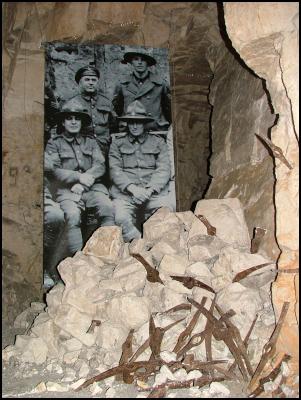French Museum Showcases NZ Tunnellers' Work
French Museum Showcases NZ Tunnellers' Work

Click to enlarge
Display inside the tunnellers’ museum Carrière Wellington.
New Zealand
Defence Force
Te Ope Kaatua O Aotearoa
Media Release
18 February 2008
FRENCH MUSEUM SHOWCASES NZ TUNNELLERS' WORK
New Zealand Defence Force (NZDF) personnel attended the opening of a museum in France last week which showcases the tunnel network built by brave New Zealand tunnellers and used by thousands of British troops during WW1.
The vast underground city under the city of Arras in northern France was built between 1916 and 1918 by members of the New Zealand Tunnelling Company, who were specially recruited from the gold and coal mining districts of New Zealand.
The 400-strong Kiwi tunnellers, who had undertaken only basic military training, worked to combat the Germans burrowing under no-man’s land to blow up and destroy the enemy trenches above.
NZDF Defence Attaché Brigadier Warren Whiting who attended the opening ceremony on 15 February said, “The tunnellers from New Zealand that worked here undertook an incredible task. That their efforts are being remembered with this museum is not only a magnificent gesture by the town of Arras but highly appropriate.”
The Arras Museum, known as the Carrière Wellington, is located in the tunnels themselves. The Carrière is a memorial to those who died in the Battle of Arras and those who helped in the construction of the tunnels.
The museum is 22 metres underground and consists of light and sound shows that allow visitors to see how the tunnels were built and what life was like there. The museum covers the discovery of the caverns/quarries, vestiges of the quarries of the Middle Ages, the military strategy for the use of the tunnels, the work of the tunnellers 1916 to 1917 as well as the Battle of Arras of April 1917. The tunnels still retain graffiti and other traces of the soldiers’ time underground. Around 60, 000 visitors are envisaged each year.
The tunnels were closed up after 1945 and lay undiscovered until 1990. Since then considerable work has been conducted at the tunnels site to enable the opening of the museum.
Last year NZDF personnel attended the unveiling of a memorial to mark the 41 New Zealand tunnellers who lost their lives at Arras and the 151 who were wounded – many who were buried under tonnes of rubble from German counter-mining.
ENDS
Background: The New Zealand Tunnelling Company
numbered 16 officers and 407 other ranks, plus one officer
and two NZ Medical Corps, 19 NZ Army Service Corps, and one
NZ Army Pay Corps, a total of 446.
The Kiwi tunnellers joined a number of large chalk quarries built in medieval times to develop two tunnel systems running under the main roads of Arras. In one tunnel system each cave is named after a New Zealand town – Russell, Auckland, New Plymouth, Wellington, Nelson, Blenheim, Christchurch, Dunedin, and finally, just before the German front line, Bluff.
Working parties to assist the tunnellers were sent from the New Zealand Division and included Maori and Pacific Islanders of the New Zealand Pioneer Battalion.
Through the winter of 1916 as the town of Arras above was destroyed by German artillery the underground city grew large enough to accommodate 20,000 men. There was running water, electric lighting, kitchens, latrines, a light rail system and a medical centre with a fully equipped operating theatre.
On 9 April 1917 15,000 men moved through the tunnels to launch the Battle of Arras.
After the Battle of Arras the New Zealand tunnellers remained in France, repairing roads, developing other tunnel systems, and building and repairing bridges. They returned to New Zealand in March 1919.


 Braden Currie: Sets Sights On The Ironman North American Championships In Texas
Braden Currie: Sets Sights On The Ironman North American Championships In Texas Whanganui Regional Museum: Historic Wedding Dress Unveiled, A Piece Of Marton’s Heritage
Whanganui Regional Museum: Historic Wedding Dress Unveiled, A Piece Of Marton’s Heritage Donovan Ryan: Local Runner Takes Out Frontrunner Christchurch Marathon
Donovan Ryan: Local Runner Takes Out Frontrunner Christchurch Marathon University of Auckland: Tributes Flow For Much Loved Pacific Leader Melegalenu’u Ah Sam
University of Auckland: Tributes Flow For Much Loved Pacific Leader Melegalenu’u Ah Sam NZEI: Ministry Of Education Cuts Will Disproportionately Affect Pasifika
NZEI: Ministry Of Education Cuts Will Disproportionately Affect Pasifika Day One Hapai te Haeata: Call To Action For Young Filmmakers Against The Backdrop Of Funding Cuts
Day One Hapai te Haeata: Call To Action For Young Filmmakers Against The Backdrop Of Funding Cuts